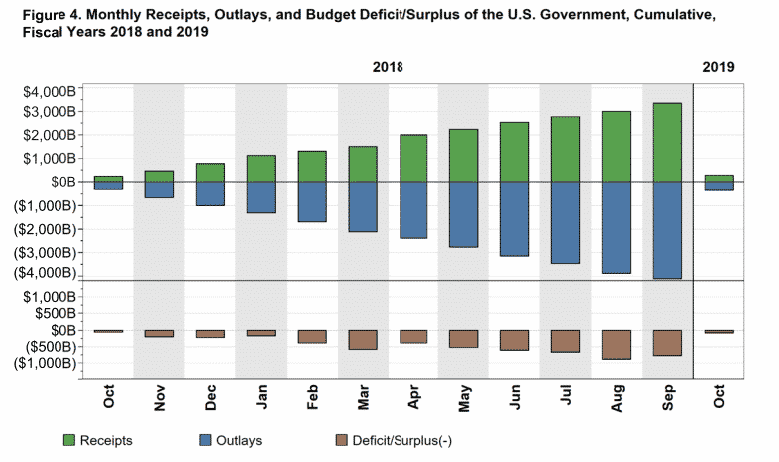Trump Administration on Track for $1 Trillion Budget Deficit This Year
The Trump administration is on track to post a 2019 fiscal year budget deficit of over $1 trillion. These are the kind of budget deficits we would expect to see during a deep recession, not an “economic boom.”
The government got off to a good start at achieving this illustrious achievement last month. According to the Treasury Department report, the deficit came in at $100.5 billion in October. That represents a 58 percent increase from the $63 billion deficit recorded in October 2017. Spending rose 18 percent year-on-year. Revenues only increased by 7 percent. The month-on-month increase was impacted by a quirk in the calendar. Total outlays were much higher this October compared to last year because Social Security payments for October 2017 went out in September due to Oct. 1 falling on the weekend. Nevertheless, we should have seen a decrease in this year’s September outlays compared to last year and that didn’t happen. The September 2018 deficit was significantly bigger (119.116) than September 2017 ($7.886 billion) even without the October Social Security payments falling in September this year. The bottom line is spending is going up year-over-year.
The month-on-month increase was impacted by a quirk in the calendar. Total outlays were much higher this October compared to last year because Social Security payments for October 2017 went out in September due to Oct. 1 falling on the weekend. Nevertheless, we should have seen a decrease in this year’s September outlays compared to last year and that didn’t happen. The September 2018 deficit was significantly bigger (119.116) than September 2017 ($7.886 billion) even without the October Social Security payments falling in September this year. The bottom line is spending is going up year-over-year.
Spending last month continued the pace of the last fiscal year. The federal government ended 2018 with the largest budget deficit since 2012. Uncle Sam ended 2018 $779 billion in the red, adding to the ballooning national debt. The CBO forecast this year’s deficit will come in close to $1 trillion. The current Treasury Department estimate projects a total fiscal 2019 deficit over the $1 trillion mark, coming in at $1.085 trillion.
The national debt expanded by more than $1 trillion in fiscal 2018. It currently stands at over $21.7 trillion. According to data released by the Treasury Department, fiscal 2018 gave us the sixth-largest fiscal-year debt increase in the history of the United States. (If you’re wondering how the debt can grow by a larger number than the annual deficit, economist Mark Brandly explains here.)
…click on the above link to read the rest of the article…
